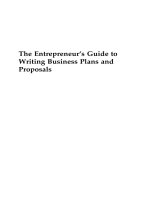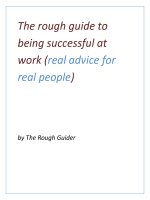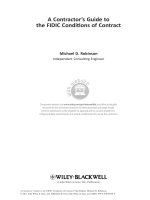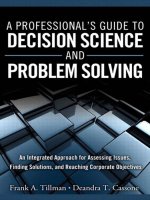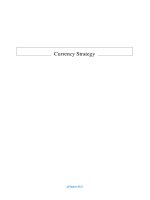Be a winner a science teachers guide to writing successful grant proposals
Bạn đang xem bản rút gọn của tài liệu. Xem và tải ngay bản đầy đủ của tài liệu tại đây (1.67 MB, 170 trang )
Be a
WINNER!
Tea
ch
A Science
Patty McGinnis
Kitchka Petrova
roposals
nt P
Gra
riting Succ
W
o
t
e
d
i
essf
u
G
ul
re ’s
Patty McGinnis
Kitchka Petrova
Arlington, Virginia
Claire Reinburg, Director
Wendy Rubin, Managing Editor
Rachel Ledbetter, Associate Editor
Amanda O’Brien, Associate Editor
Donna Yudkin, Book Acquisitions Coordinator
Art and Design
Will Thomas Jr., Director
Printing and Production
Catherine Lorrain, Director
National Science Teachers Association
David L. Evans, Executive Director
David Beacom, Publisher
1840 Wilson Blvd., Arlington, VA 22201
www.nsta.org/store
For customer service inquiries, please call 800-277-5300.
Copyright © 2016 by the National Science Teachers Association.
All rights reserved. Printed in the United States of America.
19 18 17 16 4 3 2 1
NSTA is committed to publishing material that promotes the best in inquiry-based science education. However, conditions
of actual use may vary, and the safety procedures and practices described in this book are intended to serve only as a guide.
Additional precautionary measures may be required. NSTA and the authors do not warrant or represent that the procedures
and practices in this book meet any safety code or standard of federal, state, or local regulations. NSTA and the authors
disclaim any liability for personal injury or damage to property arising out of or relating to the use of this book, including
any of the recommendations, instructions, or materials contained therein.
Permissions
Book purchasers may photocopy, print, or e-mail up to five copies of an NSTA book chapter for personal use
only; this does not include display or promotional use. Elementary, middle, and high school teachers may
reproduce forms, sample documents, and single NSTA book chapters needed for classroom or noncommercial,
professional-development use only. E-book buyers may download files to multiple personal devices but are
prohibited from posting the files to third-party servers or websites, or from passing files to non-buyers. For
additional permission to photocopy or use material electronically from this NSTA Press book, please contact the
Copyright Clearance Center (CCC) (www.copyright.com; 978-750-8400). Please access www.nsta.org/permissions for
further information about NSTA’s rights and permissions policies.
Catologing-in-Publication Data are available from the Library of Congress.
Names: McGinnis, Patty, 1958- | Petrova, Kitchka, 1958Title: Be a winner! : a science teacher’s guide to writing successful grant
proposals / Patty McGinnis and Kitchka Petrova.
Other titles: Writing successful grant proposals
Description: Arlington, VA : National Science Teachers Association, [2016] |
Includes bibliographical references and index. | Description based on
print version record and CIP data provided by publisher; resource not
viewed.
Identifiers: LCCN 2016018353 (print) | LCCN 2016008716 (ebook) | ISBN
9781681400020 (epub) | ISBN 9781681400013 (print) | ISBN 9781681400020
(e-book)
Subjects: LCSH: Proposal writing in research. | Science--Research grants.
Classification: LCC Q180.55.P7 (print) | LCC Q180.55.P7 M34 2016 (ebook) |
DDC 507.1/2--dc23
LC record available at />The Next Generation Science Standards (“NGSS”) were developed by twenty-six states, in collaboration with the
National Research Council, the National Science Teachers Association, and the American Association for the
Advancement of Science in a process managed by Achieve, Inc. The NGSS are copyright © 2013 Achieve, Inc.
All rights reserved.
Dedication
To our students, who were the inspiration for this book.
CONTENTS
PREFACE........................................................................................... ix
ACKNOWLEDGMENTS...................................................................... xi
ABOUT THE AUTHORS.................................................................... xiii
INTRODUCTION............................................................................... xv
CHAPTER 1
The Top 10 Reasons to Write a Grant Proposal...................................................... 1
CHAPTER 2
Identifying and Ref ining Ideas for Potential Grant Proposals...................................... 7
CHAPTER 3
Getting Started: May the FORCE Be With You!..................................................... 15
CHAPTER 4
Grant Proposal Components........................................................................ 23
CHAPTER 5
Supplemental Grant Components.................................................................. 57
CHAPTER 6
NGSS: A Valuable Tool for Designing Winning Grant Proposals.................................. 65
CHAPTER 7
Submitting Your Grant: Keep Those Fingers Crossed!............................................. 77
CHAPTER 8
Managing Your Funded Project..................................................................... 81
CHAPTER 9
You’ve Only Just Begun!............................................................................ 93
CONTENTS
CHAPTER 10
Some Final Words of Advice........................................................................ 99
APPENDIX 1
Dream Big! Grant Proposal Writing Templates.................................................. 101
APPENDIX 2
Grant Proposal Rubric............................................................................. 117
APPENDIX 3
Using the NGSS as a Blueprint.................................................................... 121
APPENDIX 4
Grant Listings and Proposal Resources........................................................... 125
APPENDIX 5
FAQs About the Grant Proposal Writing Process................................................. 127
APPENDIX 6
Grant Resources at State Departments of Education............................................ 133
APPENDIX 7
National Science Teachers Association Position Statements.................................... 139
APPENDIX 8
Teaching Awards................................................................................... 141
INDEX............................................................................................ 145
PREFACE
T
hese are truly exciting times for science educators. Emerging technologies,
the Common Core State Standards, and the Next Generation Science Standards are
affecting the delivery of science instruction in this country and have combined
in a perfect storm of opportunity for you and your students. No matter what you
aspire to accomplish, whether it is to acquire the funds to conduct innovative
investigations in your classroom, enhance your professional skills, or create a new
informal learning opportunity for your students, this book is your guide to successful grant proposal writing.
As frequent workshop presenters and authors of a popular short course about
writing grant proposals, we realize that many teachers find the process intimidating. Over the last two decades, we have accumulated a great deal of experience
writing grant proposals and receiving grants for projects in our classrooms. We are
familiar with what a sound K–12 classroom grant proposal looks like, having served
on grant review committees over the years and having witnessed firsthand the
enthusiasm that new equipment or otherwise financially impossible opportunities
can bring to our students. We have brought thousands of dollars into our respective schools, have received funding to travel to foreign countries for the purpose of
working on educational and research projects, and have been selected for participation in numerous competitive professional development opportunities that required
us to clearly convey our passion for improving student learning. All of these activities are within your reach, and this book will help you achieve them.
Although there are other books related to the topic of grant proposal writing,
this book is unique in that it addresses the specifics of acquiring grants for the
purpose of incorporating innovative science, technology, engineering, and mathematics (STEM) experiences in K–12 classrooms. We strongly believe classroom
science teachers, science coaches, district curriculum developers, and informal
science educators will find this book valuable and useful for increasing the educational opportunities of students in the science classroom.
Õ
Be a WINNER!
ix
ACKNOWLEDGMENTS
T
he completion of this book was made possible through the efforts of several
individuals. We would like to thank the anonymous reviewers who provided
feedback on our initial book proposal and the completed manuscript. Their
comments and suggestions helped us examine our ideas and writing from different
perspectives and ultimately contributed to the creation of a book designed to motivate and guide K–12 teachers of science through the grant proposal writing process.
We would also like to express our sincere appreciation to National Science
Teachers Association (NSTA) editors Claire Reinburg and Wendy Rubin for
answering our questions throughout the writing process and to Amanda O’Brien
for carrying out the final editing. We would also like to thank the copyeditor,
Teresa Barensfeld. A special thank you to Janeen Marzewski for reading and
providing suggestions on our manuscript. Finally, thank you to our families for
their support and encouragement throughout the writing process.
Õ
Be a WINNER!
xi
ABOUT THE AUTHORS
Patty McGinnis is a National Board Certified Teacher with more than 25 years of
teaching experience at the grade 7–12 level. She has recieved numerous grants and
awards that have engaged her students in innovative science investigations. Patty
teaches at Arcola Intermediate School in Eagleville, Pennsylvania, and has an EdD
in educational technology from Boise State University. Her interests include the
use of technology in supporting science practices. Patty is a frequent presenter at
science conferences and served as National Science Teachers Association’s division director for middle-level science teaching from 2012 to 2015. She is thankful
for the support of her husband, Bob, and of her three incredible children, Kathleen, Matthew, and Marybeth.
Kitchka Petrova is a National Board Certified Teacher in early adolescence science. She holds a PhD in microbiology from Moscow University M. V. Lomonossov,
Russia, and worked as a research scientist in Bulgaria prior to immigrating to
the United States. She was a middle school science teacher in private and public schools in Miami-Dade County, Florida, for 12 years. During that time, she
received funding from local, state, and national organizations to support projectbased inquiry learning for her students. During the 2008–2009 school year, she
served as an Albert Einstein Distinguished Educator Fellow at the National Science Foundation in Arlington, Virginia. Kitchka is currently pursuing a doctoral
degree in education policy and evaluation at Florida State University, with a focus
on science, technology, engineering, and mathematics (STEM) education policies
and initiatives.
Õ
Be a WINNER!
xiii
INTRODUCTION
C
ongratulations! By opening this book you are well on your way to making
your professional dreams come true! As a science educator, you are concerned
with the state of science education in our K–12 schools, and you understand
the importance of facilitating your students’ science learning through the science and engineering practices identified in the Next Generation Science Standards
(NGSS). Unfortunately, funds for purchasing materials are not always available in
schools, thus requiring you to seek outside funding opportunities. Given the economic situation of many school districts, it is more imperative than ever to master
the art of grant proposal writing to secure funds for innovative classroom projects.
Although intimidating, obtaining a grant to carry out your dream is within your
scope. This book is designed to guide you through the process of writing a successful grant proposal and encourage you to apply your newly developed skills to
pursue other professional development opportunities.
This book is aimed specifically toward the K–12 science educators who are
interested in obtaining classroom grants for the purpose of extending the learning
opportunities for their students and themselves. This might be achieved by adding
an expensive piece of equipment to the science lab, taking students on a research
field trip, obtaining funding to attend a professional development activity or event
that will enhance your teaching, or seeking an opportunity available specifically
to science educators.
Consider the following points:
• Many grant programs do not receive enough qualified proposals.
• If you don’t apply, you’ll never win!
• A grant may re-energize your teaching.
• The more you write, the easier it gets.
Our goal in writing this book was to take the mystery out of the grant proposal
writing process by helping you learn how to address typical grant proposal components in your writing. You’ll also glean tips regarding how to locate funding
opportunities at the local, state, and national level and learn how to tailor your
idea to a funding agency’s requirements. Although we can’t guarantee that you’ll
enjoy the writing process (writing is hard work!), we are certain you will be proud
Õ
Be a WINNER!
xv
INTRODUCTION
of your end product. We use a workbook approach that explains how to write the
components typically required by funders of K–12 classroom grants. Chapter 1
outlines the reasons for writing grant proposals and seeking funding. The outcomes for students and educators are highlighted as a way to motivate and inspire
you to pursue funding for your innovative teaching ideas. Chapter 2 describes
what is meant by a grant and will help you to identify funding organizations and
sources of inspiration for potential projects. In Chapter 3, you’ll learn why it is
important to align your proposal with the funding agency requirements, and
Chapter 4 walks you through developing and writing the standard grant components. Chapter 5 addresses supplemental grant components that funding agencies
may require, such as lesson plans, letters of support, and project vitae. The use of
the NGSS as a template for your grant proposal is addressed in Chapter 6. Chapter 7 provides tips concerning proposal submission along with how to deal with
rejection from funding agencies. Chapter 8 contains advice for implementing your
funded project; topics such as how to work with your school district to set up a designated account for your grant funds and how to deal with unexpected or unforeseen challenges are addressed. You’ll find that the skills required for successful
grant proposal writing can be applied to numerous other opportunities for K–12
teachers. A variety of professional opportunities, such as research experiences, fellowships, and National Science Teachers Association (NSTA) recognition awards,
are highlighted in Chapter 9. The closing chapter offers some final words of advice
regarding how to pursue these opportunities and how to work collaboratively
with colleagues, administrators, and parents.
So what’s stopping you? There is no better time than now to make your dreams
come true!
xvi
National Science Teachers Association
p1
0
CHAPTER
1
p o s al
Pro
The To
nt
to Write a
s
n
o
s
Gra
a
e
R
Y
ou may have a multitude of reasons for seeking a grant, and no doubt you
already have an idea for a grant proposal in mind. Although the primary goal
for most science teachers is to improve student learning, there are many other
reasons for writing a grant, including some that you may not have previously
considered. As you read over the following list, open your mind to the possibilities that a grant can have to help you positively influence your students’ growth
while expanding your professional life. You’ll no doubt begin visualizing projects,
investigations, and opportunities that extend well beyond your initial ideas.
Õ
Be a WINNER!
1
CHAPTER 1
Reason 1: To Nurture and Inspire Your Students’
Appreciation of Science
Whether you are a member of a teaching team or an individual teacher, your primary focus is to increase learning within your classroom. A grant can make it
possible for you to buy supplies, equipment, and other materials that will enrich
your classroom instruction and improve student learning. As a teacher of science,
you have a tremendous advantage over other subject-area teachers. Science is all
around us. It pervades our everyday lives, making it relatively easy to connect
scientific principles to real-world experiences—something that many funding
agencies look for when evaluating a grant proposal. Such agencies are extremely
supportive of projects that promote student understanding and learning of science
through authentic experiences and will gladly provide funds for the purchase of
necessary equipment and supplies. Additionally, it is relatively easy to align either
the Next Generation Science Standards (NGSS) or your state science standards to a
funding agency’s mission when submitting a grant proposal.
Reason 2: To Engage Students in Science and Engineering
Practices
A good example of a classroom investigation that involved a real-world connection to physical science is the funded Let’s Go Solar proposal discussed in Chapter 6
(p. 65). Using grant-funded solar houses, students were able to observe the greenhouse effect and learn about alternative energy resources while deepening their
understanding of energy and the process of energy transfer. The grant also paid
for solar cars, which were used to measure speed and velocity in student-designed
experiments that investigated how motion and energy are related. Similar projects
in which students are engaged in learning by applying science and engineering
practices are generally appealing to funders.
Reason 3: To Launch New STEM Programs
Currently, there is great interest in improving science, technology, engineering,
and mathematics (STEM) education and in increasing the number of students who
are prepared to continue their education in these fields. One has to look no further
than the White House’s Educate to Innovate initiative (www.whitehouse.gov/issues/
education/k-12/educate-innovate) to see that this focus is being taken seriously. In
response to the call to improve the teaching of STEM disciplines, many schools are
2
National Science Teachers Association
The Top 10 Reasons to Write a Grant Proposal
interested in offering additional science and engineering courses, Maker Clubs,
and other opportunities for students of all ages. Obtaining grant money could
facilitate this process and enrich your students’ experiences. If you decide to pursue the process of obtaining grant money to start a STEM program at your school,
you will need support from teachers and administrators, but the rewards and
returns of such an endeavor will be tremendous.
Reason 4: To Collaborate With an Informal Science
Education Organization
Science museums, state parks, national parks, and other nonprofit organizations
are hubs of informal science learning that typically offer a multitude of programs
that merge science content with real-world applications. Attendance at these programs, however, is not always free. Additionally, you may need funds for transportation to the site or for the purchase of consumable materials. Securing funds
to work with these entities can be mutually beneficial and rewarding; very often
students who visit science museums and parks on field trips develop long-term
interests in the functions of these organizations and choose to volunteer or to
become counselors for summer camps organized by these organizations. Needless
to say, such activities help to channel student interest in science and promote their
engagement in the work of community organizations.
Reason 5: To Fund Professional Development Opportunities
There are a myriad of professional development opportunities for K–12 science
teachers. Although most occur within the United States, overseas programs also
exist. Typically, the applications for such opportunities resemble a small grant
proposal, requiring you to explain why you should be selected, the projects you
will complete with your students after the training, and how your students will
benefit from you attending the professional development activity. The key to being
selected is your ability to outline and submit an application that is well supported
with evidence that you possess compelling ideas regarding how to use this professional development opportunity to enhance your students’ learning.
Reason 6: To Grow as a Professional Educator
Grant writing involves in-depth reflection and examination of your teaching and
how it contributes to your students’ learning of science concepts. As you justify
Õ
Be a WINNER!
3
CHAPTER 1
your ideas to a grant funder, you will find that the process of reflecting on your
teaching will help you improve your practice. Although it is unlikely that every
grant proposal you write will be funded, the growth you will experience as a result
of the process will ultimately benefit your students.
Reason 7: To Participate in the Selection Process of
Funding Organizations
Many organizations that fund educational projects require a teachers’ perspective when deciding what proposals to fund. Sometimes simply contacting the
organizations and explaining that you would like to volunteer as a judge will
be sufficient to put you on the list of potential judges. It is not unusual for
educators who have received grants or professional development from a funding agency to be invited to serve as judges in the selection of the next round of
funded proposals. This process, which often involves readings and discussions
with other passionate educators, will provide insight into a variety of classrooms and teaching practices.
Reason 8: To Receive Professional Recognition
Being awarded grant funds to implement innovative ideas in your classroom
may propel you into becoming someone whom others seek out for expertise and
advice. Your students and their parents, your colleagues, your school district,
and possibly even your state may recognize you as someone who is passionate
about enhancing student learning and who knows how to fund novel ideas. This
type of recognition can be very helpful if you apply for a teaching award at the
district, state, or nationwide level.
Reason 9: To Earn Professional Endorsement
Whether the granting organization is an educational one or not, obtaining external
funds to implement your own classroom projects is a validation that your teaching
practices, ideas, and goals have merit and are worth funding.
Reason 10: To Attain Personal Satisfaction
There is nothing like receiving a notification that your idea will be funded. It is
both exciting and personally satisfying to know that your vision was successfully
conveyed to the funder. Even more important, the opportunities that grant funds
4
National Science Teachers Association
The Top 10 Reasons to Write a Grant Proposal
will bring to your classroom will reinvigorate your teaching, positively influence
student learning, and increase your personal satisfaction with your role as a science educator.
Exercise
Think about your own motivations for writing a grant proposal. The list provided in this chapter is by no means complete because it is not personalized.
Can you write one or more reasons why you will start writing grant proposals?
Õ
Be a WINNER!
5
nt Proposals
CHAPTER
2
Gr a
Identifying and R
e
al
eas for Pot
d
I
g
ent
if nin
i
Y
ou may be asking yourself, What exactly is a grant? A grant is the equivalent
of a monetary gift that is given to the recipient in exchange for completing a
specific project or other work that closely aligns to the mission and the goals
of the funding agency. You can think of a grant as a contract between you and the
funder. Although you don’t have to pay the money back, you essentially are agreeing to carry out your proposal and ensure that your project adheres to the funding
requirements specified by funding agency.
Grants are awarded by both nonprofit and for-profit organizations, as well as by
local, state, and federal government entities that often have money designated to
support specific types of educational opportunities. Most granting entities require
that individuals seeking grants submit a grant proposal that outlines the idea and
clarifies any points that the funding agency requires. Some grant applications
Õ
Be a WINNER!
7
CHAPTER 2
are fairly complex, requiring a great deal of effort on your part, whereas other
grant applications are somewhat simple, requiring only a few well-thought-out
paragraphs. Regardless of the grant you decide to pursue, the key to successfully
securing funding for your dream is for your passion to be clearly conveyed via
your writing. This will require convincing the funder that your dream is one that
will have a lasting effect on your life and on the lives of your students.
In our work with teachers during presentations on grant proposal writing,
we have noticed that many wish to pursue a grant for the purpose of obtaining
equipment or supplies. Although this is a commendable desire, we believe that
your grant proposal will have an increased likelihood of being funded if you can
strongly tie the need for classroom materials to student learning. Once you have
identified a particular piece of equipment as being essential to your classroom,
explain its relevance to your project goals. If you need to refine an idea that you
currently have, or you have yet to identify an idea, you may find one or more of
the following sources helpful in clarifying your thoughts so that your idea can be
developed into a grant proposal.
Sources for Ideas
Your Students’ Questions
Your greatest source of ideas is your students. Students are often capable of asking amusing and ingenious questions even though they may not always possess
enough knowledge to know what will or will not work. Whether or not you feel
comfortable allowing students to perform open inquiries, by eliciting student
questions, you are validating their thinking and engaging them in the science and
engineering practices outlined in the Next Generation Science Standards (NGSS;
NGSS Lead States). Careful facilitation of classroom discussions can guide your
students toward conducting inquiries designed to foster conceptual understanding or solve a community problem.
In addition to garnering ideas from them, you may want to consider enlisting
your students to write portions of the grant. High school students can use this
authentic experience to develop a student research project, while younger students
can develop ideas for improving some aspect of their school community. If you like
the idea of engaging students in the grant writing process, you may want to peruse
the grant writing lessons found at The Teaching Channel (www.teachingchannel.org)
and at Learning to Give (www.learningtogive.org).
8
National Science Teachers Association


